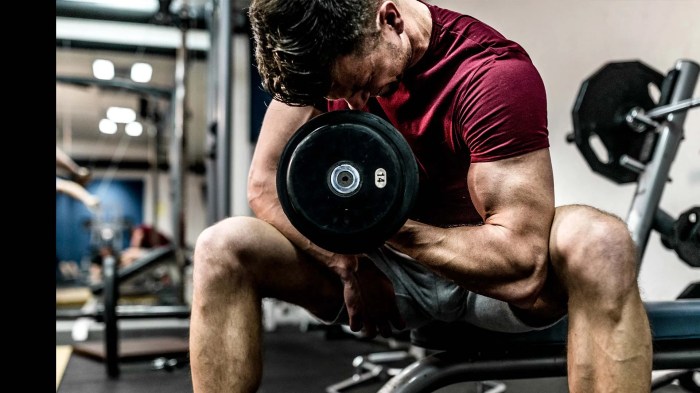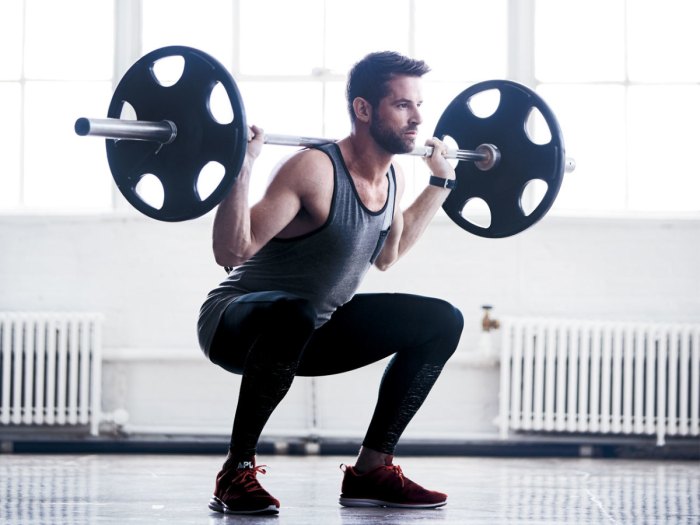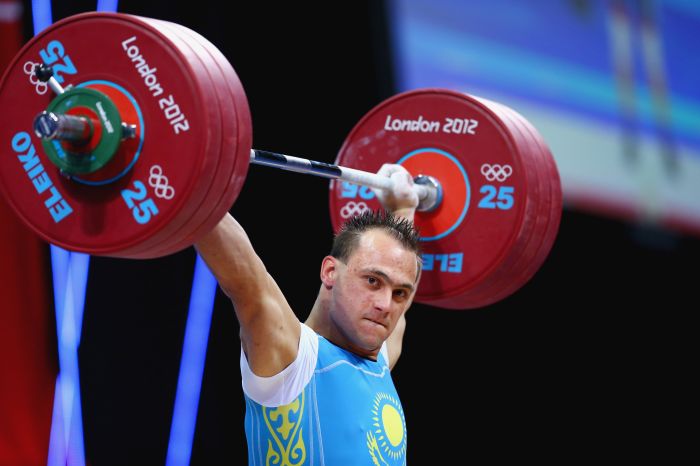Weightlifting lifts are a cornerstone of any effective fitness routine, offering a myriad of benefits that extend far beyond the gym. Join us as we delve into the world of weightlifting lifts, exploring their proper techniques, remarkable advantages, and essential safety measures.
Whether you’re a seasoned lifter or just starting your fitness journey, this guide will empower you to unlock the full potential of weightlifting lifts.
From the fundamental squat to the dynamic overhead press, we’ll break down each lift with detailed instructions and expert tips. Discover how to execute these exercises safely and effectively, maximizing their benefits and minimizing the risk of injury. Along the way, we’ll uncover the science behind weightlifting lifts, explaining how they contribute to building strength, enhancing muscle mass, and improving overall health.
Weightlifting Programs

Whether you’re a seasoned weightlifter or just starting out, choosing the right weightlifting program is crucial for maximizing your results. Different programs cater to varying fitness levels and goals, so understanding the options is essential.
Beginner Weightlifting Programs
For beginners, it’s recommended to start with a full-body program that targets all major muscle groups in one workout. This helps build a foundation of strength and muscular endurance. Some popular beginner programs include:
- Starting Strength
- StrongLifts 5×5
- Greyskull LP
Intermediate Weightlifting Programs
As you progress, you may want to switch to a more specialized program that focuses on specific goals. Intermediate programs often involve higher training volume and intensity. Some examples include:
- 5/3/1
- Texas Method
- Juggernaut Method
Advanced Weightlifting Programs
Advanced weightlifting programs are designed for experienced lifters with exceptional strength levels. These programs typically involve highly individualized training protocols and require a high level of recovery. Some examples include:
- Sheiko
- Conjugate Method
- Westside Barbell Method
Designing a Personalized Weightlifting Program
To create a personalized weightlifting program, consider the following factors:
- Fitness level and goals
- Training experience
- Available time and equipment
- Recovery capacity
Consult with a qualified fitness professional or coach for guidance on developing a program that aligns with your specific needs.
Benefits and Drawbacks of Different Weightlifting Programs
| Program | Benefits | Drawbacks |
|---|---|---|
| Beginner | – Builds a foundation of strength and endurance- Suitable for all fitness levels | – May not be specific enough for advanced goals |
| Intermediate | – Allows for specialization and progress- Can improve strength and muscle mass | – Requires more training time and intensity |
| Advanced | – Maximizes strength and power- Allows for highly individualized training | – Requires a high level of recovery- May not be suitable for all lifters |
“Weightlifting is not just about building muscles. It’s about building strength, confidence, and a better body.”– Arnold Schwarzenegger
Weightlifting Nutrition

Weightlifters have unique nutritional needs to support their demanding training and recovery. A healthy diet that meets these needs is crucial for maximizing performance, building muscle, and achieving weightlifting goals.
The key nutritional requirements for weightlifters include:
Calorie Intake
- Weightlifters need to consume adequate calories to support their high energy expenditure during training and recovery.
- Calorie needs vary depending on factors such as body weight, activity level, and training intensity.
- A registered dietitian or sports nutritionist can help determine the optimal calorie intake for individual needs.
Protein Intake
- Protein is essential for building and repairing muscle tissue.
- Weightlifters should aim for a protein intake of 1.6-2.2 grams per kilogram of body weight per day.
- Good sources of protein include lean meats, poultry, fish, eggs, dairy products, and plant-based proteins like beans and lentils.
Carbohydrate Intake
- Carbohydrates provide energy for weightlifting workouts.
- Weightlifters should consume a sufficient amount of carbohydrates, especially before and after training.
- Good sources of carbohydrates include whole grains, fruits, vegetables, and starchy vegetables.
Hydration
- Staying hydrated is crucial for weightlifting performance.
- Weightlifters should drink plenty of water before, during, and after workouts.
- Electrolyte-rich beverages, such as sports drinks, can be beneficial during intense or prolonged workouts.
Supplementation
- Certain supplements can be beneficial for weightlifters, such as creatine, beta-alanine, and caffeine.
- It is important to consult with a healthcare professional before taking any supplements.
– Discuss the potential benefits and risks of weightlifting supplements, including
Weightlifting supplements are substances that are taken to improve performance or recovery from exercise. They can be beneficial for some people, but they also come with some risks. It is important to be aware of the potential benefits and risks before using any supplements.There are many different types of weightlifting supplements, including:* Creatine: Creatine is a natural substance that helps to increase muscle strength and power.
It is one of the most well-researched supplements and is generally considered to be safe and effective.
Protein powders
Protein powders are a convenient way to increase protein intake. Protein is essential for muscle growth and repair.
Pre-workout supplements
Pre-workout supplements are taken before a workout to improve energy and focus. They typically contain ingredients such as caffeine, beta-alanine, and creatine.
Post-workout supplements
Post-workout supplements are taken after a workout to promote muscle recovery. They typically contain ingredients such as protein, carbohydrates, and BCAAs.
Recovery Methods for Weightlifters
Recovery is an essential part of any weightlifting training plan. It allows your body to repair itself and rebuild stronger, so you can continue to make progress in the gym. There are a variety of recovery methods available to weightlifters, each with its own benefits and drawbacks.
Active Recovery
Active recovery involves engaging in light physical activity on your rest days. This helps to promote blood flow and circulation, which can help to reduce muscle soreness and speed up recovery. Some examples of active recovery activities include:
- Going for a walk or jog
- Swimming
- Cycling
- Yoga
- Pilates
Passive Recovery
Passive recovery involves resting completely on your rest days. This allows your body to fully recover from your workouts. Some examples of passive recovery activities include:
- Sleeping
- Reading
- Watching TV
- Taking a nap
Cryotherapy
Cryotherapy is a relatively new recovery method that involves exposing your body to extremely cold temperatures. This can help to reduce inflammation and muscle soreness. Cryotherapy can be done in a variety of ways, including:
- Immersing yourself in a cold bath
- Using a cryotherapy chamber
- Applying ice packs to your muscles
Table of Recovery Methods
The following table summarizes the benefits and drawbacks of different recovery techniques:
| Recovery Method | Benefits | Drawbacks |
|---|---|---|
| Active Recovery |
|
|
| Passive Recovery |
|
|
| Cryotherapy |
|
|
Choosing the Right Recovery Method
The best recovery method for you will depend on your individual needs and preferences. If you are new to weightlifting, it is a good idea to start with passive recovery. As you get stronger and more experienced, you can add active recovery and cryotherapy to your routine.
It is also important to listen to your body and rest when you need to. If you are feeling particularly sore or tired, it is best to take a day or two off from training and focus on recovery.
Weightlifting Variations

Weightlifting exercises can be modified to target specific muscle groups or address limitations. By altering the grip, stance, or range of motion, you can emphasize different areas of the body and challenge yourself in new ways.
Barbell Variations
- Close Grip Bench Press:Focuses on the triceps by bringing the hands closer together on the bar.
- Wide Grip Bench Press:Emphasizes the chest by placing the hands wider apart on the bar.
- Incline Bench Press:Targets the upper chest by elevating the bench.
- Decline Bench Press:Focuses on the lower chest by lowering the bench.
- Squat Variations:By changing the stance width and depth, you can target different quadriceps and glute muscles.
Weightlifting Competitions

Weightlifting competitions are events where athletes demonstrate their strength and skill in lifting heavy weights. These competitions can vary in format and rules, but they generally fall into three main categories: powerlifting, weightlifting, and strongman.
Powerlifting
Powerlifting is a competition in which athletes perform three lifts: the squat, the bench press, and the deadlift. The goal is to lift the most weight possible in each lift, with the total weight lifted across all three lifts determining the winner.
Powerlifting competitions are typically held in a gym or weightlifting facility, and athletes use a variety of equipment to assist them in their lifts, such as weightlifting belts, knee wraps, and wrist straps.
Weightlifting
Weightlifting is a competition in which athletes perform two lifts: the snatch and the clean and jerk. The goal is to lift the most weight possible in each lift, with the total weight lifted across both lifts determining the winner.
Weightlifting competitions are typically held in a gym or weightlifting facility, and athletes use a variety of equipment to assist them in their lifts, such as weightlifting belts, knee wraps, and wrist straps.
Strongman
Strongman is a competition in which athletes perform a variety of strength-based events, such as lifting heavy objects, pulling vehicles, and carrying heavy weights over long distances. The goal is to complete the events as quickly and efficiently as possible, with the athlete with the best overall performance being declared the winner.
Strongman competitions are typically held outdoors, and athletes use a variety of equipment to assist them in their events, such as weightlifting belts, knee wraps, and wrist straps.
Weightlifting Culture

Weightlifting culture encompasses the shared values, beliefs, and traditions of individuals who engage in the sport of weightlifting. It has a rich history and a strong sense of community, with lifters supporting and motivating each other in their pursuit of strength and athleticism.
History and Values
Weightlifting has its roots in ancient Greece, where it was an integral part of the Olympic Games. The sport was revived in the 19th century, and has since grown in popularity around the world. Weightlifters value strength, discipline, and camaraderie.
They believe in pushing their limits, both physically and mentally, and in striving for excellence in all that they do.
Traditions, Weightlifting lifts
Weightlifting has a number of traditions that are unique to the sport. These include:
- The use of chalk to improve grip.
- The wearing of weightlifting belts and wrist wraps to provide support and stability.
- The practice of “spotting” other lifters, which involves assisting them in completing a lift safely.
Weightlifting Injuries
Weightlifting, while beneficial, carries the risk of injuries due to the strenuous nature of the activity. Understanding these injuries and implementing preventive measures is crucial for a safe and effective workout experience.
Common Weightlifting Injuries
- Sprains:Overstretching or tearing of ligaments, causing pain, swelling, and bruising.
- Strains:Overstretching or tearing of muscles or tendons, leading to pain, stiffness, and weakness.
- Tears:Complete rupture of a muscle, tendon, or ligament, resulting in severe pain, swelling, and loss of function.
- Fractures:Breaks in bones, often caused by excessive force or impact, resulting in pain, swelling, and deformity.
Injury Prevention
- Warm-up:Prepare your body for lifting by engaging in light cardio and dynamic stretching.
- Proper Technique:Maintain good form throughout each lift to minimize stress on joints and muscles.
- Appropriate Equipment:Use weightlifting shoes, belts, and wrist wraps to provide support and stability.
- Gradual Progression:Gradually increase weight and intensity over time to avoid overloading your body.
- Rest and Recovery:Allow sufficient rest between sets and workouts to facilitate muscle repair.
Injury Treatment
RICE Protocol:
- Rest:Avoid activities that aggravate the injury.
- Ice:Apply ice packs to the affected area for 15-20 minutes at a time, several times a day.
- Compression:Use elastic bandages to wrap the injured area, reducing swelling.
- Elevation:Keep the injured area elevated above the heart to reduce blood flow and swelling.
Rehabilitation Exercises:
- Range of Motion Exercises:Gradually increase the range of motion in the injured area.
- Strengthening Exercises:Once pain subsides, perform exercises to strengthen the affected muscles and joints.
- Proprioceptive Exercises:Improve balance and coordination to prevent re-injury.
Pain Management Techniques:
- Over-the-counter pain relievers:Ibuprofen or acetaminophen can help reduce pain and inflammation.
- Heat therapy:Applying heat to the injured area can promote blood flow and reduce stiffness.
- Massage:Gentle massage can help relax muscles and reduce pain.
Table: Common Weightlifting Injuries
| Injury | Symptoms | Causes | Treatment |
|---|---|---|---|
| Sprain | Pain, swelling, bruising | Overstretching or tearing of ligaments | RICE protocol, rest, physical therapy |
| Strain | Pain, stiffness, weakness | Overstretching or tearing of muscles or tendons | RICE protocol, rest, strengthening exercises |
| Tear | Severe pain, swelling, loss of function | Complete rupture of muscle, tendon, or ligament | Surgery, immobilization, rehabilitation |
| Fracture | Pain, swelling, deformity | Breaks in bones | Immobilization, surgery, physical therapy |
Importance of Professional Medical Attention
If you experience severe pain, swelling, deformity, or loss of function, seek immediate medical attention. These symptoms may indicate a serious injury that requires professional diagnosis and treatment.
Resources for Further Information
- National Strength and Conditioning Association: https://www.nsca.com/
- American Council on Exercise: https://www.acefitness.org/
- Mayo Clinic: https://www.mayoclinic.org/
Weightlifting Lifestyle: Weightlifting Lifts
Embracing weightlifting extends beyond the gym; it becomes a way of life. Weightlifting profoundly impacts one’s overall lifestyle, fostering a positive mindset and holistic well-being.
By consistently challenging oneself with weights, individuals develop a heightened sense of self-confidence. The accomplishment of lifting heavier weights and overcoming physical challenges instills a belief in one’s abilities, translating into increased confidence in various aspects of life.
Discipline
Weightlifting demands discipline and consistency. Adhering to a structured training plan, maintaining proper nutrition, and prioritizing recovery reinforces self-discipline. This discipline spills over into other areas of life, fostering better time management, goal-setting, and decision-making.
Well-being
Weightlifting is not just about building muscle; it’s about improving overall well-being. The physical exertion releases endorphins, leading to a sense of euphoria and reduced stress levels. Additionally, weightlifting strengthens the immune system, improves cardiovascular health, and enhances sleep quality.
Final Conclusion

Weightlifting lifts are more than just exercises; they are a transformative force that can shape your body, mind, and lifestyle. Embrace the challenge of weightlifting lifts, and you’ll not only achieve your fitness goals but also cultivate a newfound sense of strength, confidence, and well-being.
Remember, the journey of weightlifting is an ongoing one, filled with both triumphs and setbacks. Embrace the process, learn from your mistakes, and never stop striving for progress. The rewards of weightlifting lifts are immeasurable, and with dedication and perseverance, they will be yours to reap.
Quick FAQs
What is the proper form for the squat?
Stand with your feet shoulder-width apart, toes slightly turned out. Lower your body by bending your knees and hips, as if sitting back into a chair. Keep your chest up and your knees aligned with your toes. Descend until your thighs are parallel to the ground, then return to the starting position by extending your knees and hips.
How can I avoid injuries while weightlifting?
Always warm up before lifting weights, and cool down afterward. Use proper form and lift within your limits. Use a spotter when lifting heavy weights. Get enough rest and recovery between workouts.
What are the benefits of weightlifting?
Weightlifting can help you build strength, muscle mass, and bone density. It can also improve your cardiovascular health, reduce your risk of chronic diseases, and boost your mood.
Leave a Reply